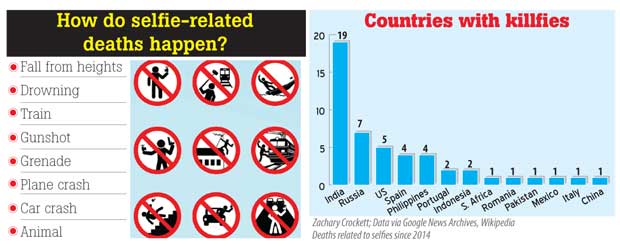Reply To:
Name - Reply Comment
 Two brothers tragically fell victim to selfie flash, as they posed for a photo at the railway tracks in Colpetty last week (Left) The last selfie before the tragic separation of the Sri Lankan couple (Right)
Two brothers tragically fell victim to selfie flash, as they posed for a photo at the railway tracks in Colpetty last week (Left) The last selfie before the tragic separation of the Sri Lankan couple (Right)
As life goes on, stumbling upon precious moments that you might want to tug onto and remember for the rest of your life is natural. To fulfil this cause, photography found its way into existence. What started as black and white photographs gradually developed into colour and now selfies have erupted into a fad fever. Although introduced as a fun new trend, selfies have today become a ridiculed and fatal threat. Falling from a 30-foot bridge to utter doom to accidentally shooting themselves with guns, people have died in the most incredulous ways, all because of posing for a selfie. Selfies do not  seem as harmless as they sound. Due to attempts to snap daring selfies to bask in the glory of popularity, selfie deaths have risen over time. An overwhelming rate of selfie fatalities has been reported from India, in most cases, people dying from drowning. Russia and the United States are not far behind. Selfie-related deaths have become a serious concern worldwide, so much so that taking selfies has been banned in several places. Selfie stick, any smart phone’s partner in crime in capturing the perfect selfie, has been banned in South Korea although they haven’t taken drastic measures in banning selfies altogether. But, will an all-out worldwide selfie ban take place soon enough? At the rate of selfie fatalities, this could be a possibility in the future. Selfie fatalities have taken the trigger in Sri Lanka since lately, with several isolated cases of selfie deaths being reported at railway tracks. Selfies are now banned in front of moving trains and railway tracks islandwide and has been declared a punishable offence. According to a research, the people who have died from the selfie mania range from the ages 14-32, a category in the prime of their lives. Is there a particular reason for the selfie bug to infect the majority of youth? Is it a psychological and social aspect related to age?
seem as harmless as they sound. Due to attempts to snap daring selfies to bask in the glory of popularity, selfie deaths have risen over time. An overwhelming rate of selfie fatalities has been reported from India, in most cases, people dying from drowning. Russia and the United States are not far behind. Selfie-related deaths have become a serious concern worldwide, so much so that taking selfies has been banned in several places. Selfie stick, any smart phone’s partner in crime in capturing the perfect selfie, has been banned in South Korea although they haven’t taken drastic measures in banning selfies altogether. But, will an all-out worldwide selfie ban take place soon enough? At the rate of selfie fatalities, this could be a possibility in the future. Selfie fatalities have taken the trigger in Sri Lanka since lately, with several isolated cases of selfie deaths being reported at railway tracks. Selfies are now banned in front of moving trains and railway tracks islandwide and has been declared a punishable offence. According to a research, the people who have died from the selfie mania range from the ages 14-32, a category in the prime of their lives. Is there a particular reason for the selfie bug to infect the majority of youth? Is it a psychological and social aspect related to age?

A huge interest in snapping photos and uploading them on social media prevails amongst today’s youth. According to Professor Amarasekera, this trend has been given prominence by those who wish to gain publicity by showing off their lifestyles, for instance by posting photos of delicacies, designer wear or supercars.
“Back in the day, a photograph was used as a mode of identification. It is not the case today. The present situation influenced by modern technology has created a photo culture. The younger  generation from adolescents to adults is more inclined towards this nugatory culture.”
generation from adolescents to adults is more inclined towards this nugatory culture.”
Professor Amarasekera reasons that this is due to the close association of technology with young lives.
“The younger generation spends more time on social media with phones, laptops and computers. Their interaction with people is restricted. In yesteryear, people only used phones to take calls and send messages. Mobile phones were not technologically-advanced back then.”
The young generation seems to have created personal freedom by excluding themselves from their family and living within their own boundaries soiled by technology. Caught up in the selfie trend beyond the point of no return, they start becoming unaware of the dangers in snapping selfies and hence fall into the clutches of untimely death.
“Whether it is on a railway track or by the sea, the place does not matter to them as they focus on capturing that perfect picture. This makes them oblivious to what goes on around them and finally fall victim to the tragedy.”
Professor Amarasekera stresses that today’s young generation is drawn to self-display through selfies to feel socially-secure, accepted and admired, and that this kind of behaviour creates ill-will on the country’s future.
“People with such mentalities do not have the country’s best interests at heart. They selfishly indulge in luxury and only express concern in their social representation. Selfie obsessions portray a person as self-absorbed and self-centred. Hence, it is hard to envision the future of the country with what the majority of youth display. To enhance sustainable development, the younger generation has to be dedicated citizens and should harbour sincere concern for the welfare of this country.”
Professor Amarasekera underscores that it is pivotal to change the attitudes of the selfie mania-struck population.
“We cannot anticipate good things for the country from the young generation unless a change in attitudes takes place.”
There are a lot of misdeeds that exist in the culture of today’s youth. Selfies add another portal to danger to this already-threatened culture. Social media has also greatly influenced a spark in selfies. Will stringent legislation curb the selfie menace? An imposed law might manipulate people and prevent them from capturing selfies in risky locations.
Professor Amarasekera feels that although this initiative will plummet the number of deaths, a law as a whole cannot accomplish changes in attitudes.
“Merely because a law bans selfies from being taken near railway tracks and moving trains, it does not mean people will avoid taking selfies in other risky locations. So what is needed here is an apt attitude change. Today, there is a huge generation gap between parents and children. This gap also has to be narrowed. Parents have to be aware of the child’s thinking pattern. Today, the main problem that exists is that children are more tech savvy than parents, and they remain naive of the dangerous extents to which a cell phone can be used.” Will a complete ban resolve the lethal selfie malady? Professor Amarasekera does not think so. “If selfies are totally banned from the country, some may point it out as a violation of human rights, which is indeed a sensitive topic. Absurd selfie-taking does not apply to anyone. After all, it is an innocent enjoyment but has turned into a ferocious monster created irresponsibly by the people. The problem lies in the locations where selfies are taken and in some cases, the intentions.”
According to Professor Amarasekera, a reason for youth to become selfie obsessed is partly due to severe competition in Sri Lanka for exams, as a lot of students sit for the exams but only a limited number qualify for state university entrance.
“This deprives many youth of a higher education and therefore leads to unemployment. Those who fall into this category often end up in unethical relationships that are led by frustration. Their mental state is tragic and therefore they resort to temporary enjoyments through several means that could give way to stray motives. Selfie-taking is one such reason. These areas should be given serious consideration.”
Taking a selfie to capture a valuable moment in life is fine. But making it a goal to take selfies every second of their life, even by posing in dangerous situations, is an unhealthy obsession. Going overboard with selfies with no control is where danger lurks and threatens lives.
According to Dr. Attygalle, although some people have coined the term ‘selfitis’ to selfie obsession, this is not a mental health disorder categorised under either of the two mental health classification systems. “However, this does not mean excessive and obsessive capturing of selfies does not have mental health aspects. Some other mental health disorders like Obsessive Compulsive Disorder and Body Dysmorphobia can, at times, manifest as excessive selfie taking.
“This also does not mean that all selfie attempts are related to mental health issues. Snapping a selfie is completely normal from a mental health perspective, but may have other social implications. Interestingly, it is mostly the youth who get into trouble with selfies. It is known that adolescents are, sometimes, prone to think more of the rewards than the consequences of their actions. Thus, this may have something to do with why many youngsters put themselves at risk, both in taking a selfie and posting them on social media. Advocating and highlighting the need for young people to take precautions related to their physical environment before taking a selfie and taking precautions related to their privacy before posting selfies are vital,” says Dr. Attygalle.